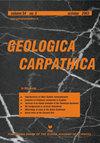Major and trace element signature of epidote-group minerals in altered pegmatites from the Petrovitsa Pb–Zn deposit of the Madan ore region, Central Rhodopes, Bulgaria: Evidence of allanite/epidote transformation
IF 1.5
4区 地球科学
Q4 GEOSCIENCES, MULTIDISCIPLINARY
引用次数: 2
Abstract
: The geochemical behaviour of major, rare, and trace elements in members of epidote-group minerals formed at different stages of magmatic and hydrothermal activity in pegmatites from the Madan ore district was studied. Accessory allanite-(Ce) and two generations of hydrothermal clinozoisite–epidote occur in hydrothermally-altered pegmatite bodies at the 820 mine level in the Petrovitsa Pb–Zn deposit. Abundant large concordant and crosscutting pegmatites (age 49.63 ± 0.94 Ma) with a thickness of more than 2 m are embedded in a high-grade metamorphic complex composed of various gneisses, amphibolites, and marbles in the area of the Petrovitsa deposit. The pegmatites consist mainly of feldspars and quartz, with plagioclases (albite–oligoclase, oligoclase–andesine, anorthite) predominating over K-feldspars. The main accessory minerals are allanite-(Ce), zircon, apatite, and an abundance of titanite. The overprinted hydrothermal mineral association is characterised by the formation of clinozoisite–epidote, adularia, chlorite, Ca-garnet, titanite, leucoxene, carbonates, hematite, and quartz. Based on petrographic observations, mineral relationships, and chemical properties, two generations of epidotes ( sensu lato ) were recognised: early epidote (Ep1) and late epidote (Ep2). Chemically, allanite-(Ce) contains high amounts of La and Th. The mineral suffered alteration due to several multiphase hydrothermal events and is partly or entirely transformed into REE-rich clinozoisite, causing depletion in REE and Th as well as enrichment of Si, Al, and Ca. The epidote 1 generation is defined chemically as clinozoisite to clinozoisite– epidote, whereas the late epidote 2 generation is clinozoisite–epidote, reaching epidote members. The REE contents in the studied epidotes from both generations are equally low with minor exceptions. The influx of later fluids percolated through and probably extracted REE from allanite and thereafter concentrated them in late-generation epidotes. This is also evidenced by some high REE contents in epidotes from both generations, formed in close proximity to allanite or titanite and/or overgrowing them, which is a sign of restricted REE transport.保加利亚中部罗多贝矿区Petrovitsa铅锌矿蚀变伟晶岩中绿帘石群矿物的主微量元素特征:榴辉石/绿帘石转化的证据
研究了马丹矿区伟晶岩中岩浆活动和热液活动不同阶段形成的绿柱石群矿物中主要元素、稀有元素和微量元素的地球化学行为。在Petrovitsa铅锌矿820矿位热液蚀变伟晶岩体中,出现了副allanite-(Ce)和两代热液斜沸石-绿帘石。在Petrovitsa矿床地区,由各种片麻岩、角闪岩和大理岩组成的高等级变质杂岩中,嵌有大量厚度大于2 m的大型和合和横切伟晶岩(年龄49.63±0.94 Ma)。伟晶岩主要由长石和石英组成,斜长石(钠长石-寡长石、寡长石-安长石、钙长石)多于钾长石。主要副矿物为褐褐铁矿(Ce)、锆石、磷灰石和丰富的钛矿。叠印热液矿物组合的特征是形成斜沸石—绿帘石、绿泥石、钙石榴石、钛矿、亮辉石、碳酸盐、赤铁矿和石英。根据岩石学观察、矿物关系和化学性质,确定了两代绿帘石:早期绿帘石(Ep1)和晚期绿帘石(Ep2)。从化学上说,allanite-(Ce)含有大量的La和Th。该矿物经过多次多期热液事件的蚀变,部分或全部转化为富REE的斜沸石,导致REE和Th的亏缺以及Si、Al和Ca的富集。绿帘石1代化学定义为斜沸石-斜沸石-绿帘石,而后期绿帘石2代为斜沸石-绿帘石,达到绿帘石成员。两代绿帘石的稀土元素含量均较低,但有少量例外。后期流体的流入渗透并可能从allanite中提取稀土元素,然后将其集中在晚期绿帘石中。两代绿帘石中均有较高的稀土元素含量,这些稀土元素与allanite或钛矿形成较近或过长,表明稀土元素运移受限。
本文章由计算机程序翻译,如有差异,请以英文原文为准。
求助全文
约1分钟内获得全文
求助全文
来源期刊

Geologica Carpathica
地学-地球科学综合
CiteScore
2.40
自引率
23.10%
发文量
26
审稿时长
>12 weeks
期刊介绍:
GEOLOGICA CARPATHICA covers a wide spectrum of geological disciplines including geodynamics, tectonics and structural geology, volcanology, stratigraphy, geochronology and isotopic geology, karstology, geochemistry, mineralogy, petrology, lithology and sedimentology, paleogeography, paleoecology, paleobiology and paleontology, paleomagnetism, magnetostratigraphy and other branches of applied geophysics, economic and environmental geology, experimental and theoretical geoscientific studies. Geologica Carpathica , with its 60 year old tradition, presents high-quality research papers devoted to all aspects not only of the Alpine-Carpathian-Balkanian geoscience but also with adjacent regions originated from the Mediterranean Tethys and its continental foreland. Geologica Carpathica is an Official Journal of the Carpathian-Balkan Geological Association.
 求助内容:
求助内容: 应助结果提醒方式:
应助结果提醒方式:


